Revisiting the Chemistry of Vinylpyrazoles: Properties, Synthesis, and Reactivity
Abstract
:1. Introduction
2. Synthesis of Vinylpyrazoles
3. Reactivity of Vinylpyrazoles
3.1. Cycloaddition Reactions
3.2. Polymerization Reactions
3.3. Halogenation and Hydrohalogenation Reactions
3.4. Difluorocyclopropanation Reactions
3.5. Phosphorylation Reactions
3.6. Ring-Closing Metathesis Reactions
3.7. Organomettalic Reactions
3.8. Transition-Metal-Catalyzed Reactions
C-H Activation Reactions
3.9. Miscellaneous
3.9.1. Reaction with Ethyl N-Trichloroethylidenecarbamate
3.9.2. Reaction with Alkanethiols
3.9.3. Reaction with Dichlorocarbene
4. Conclusions
Author Contributions
Funding
Institutional Review Board Statement
Informed Consent Statement
Data Availability Statement
Conflicts of Interest
Sample Availability
References
- Pérez-Fernández, R.; Goya, P.; Elguero, J. A review of recent progress (2002–2012) on the biological activities of pyrazoles. Arkivoc 2014, 2014, 233. [Google Scholar] [CrossRef]
- Küçükgüzel, S.G.; Senkardes, S. Recent advances in bioactive pyrazoles. Eur. J. Med. Chem. 2015, 97, 786–815. [Google Scholar] [CrossRef]
- Abrigach, F.; Touzani, R. Pyrazole derivatives with NCN junction and their biological activity: A review. Med. Chem. 2016, 6, 292–298. [Google Scholar] [CrossRef]
- Faria, J.V.; Vegi, P.F.; Miguita, A.G.C.; dos Santos, M.S.; Boechat, N.; Bernardino, A.M.R. Recently reported biological activities of pyrazole compounds. Bioorg. Med. Chem. 2017, 25, 5891–5903. [Google Scholar] [CrossRef]
- Ansari, A.; Ali, A.; Asif, M. Biologically active pyrazole derivatives. New J. Chem. 2017, 41, 16–41. [Google Scholar] [CrossRef]
- Silva, V.L.M.; Elguero, J.; Silva, A.M.S. Current progress on antioxidants incorporating the pyrazole core. Eur. J. Med. Chem. 2018, 156, 394–429. [Google Scholar] [CrossRef]
- Gomes, P.M.O.; Silva, A.M.S.; Silva, V.L.M. Pyrazoles as key scaffolds for the development of fluorine-18-labeled radiotracers for positron emission tomography (PET). Molecules 2020, 25, 1722. [Google Scholar] [CrossRef]
- Secci, D.; Bolasco, A.; Chimenti, P.; Carradori, S. The state of the art of pyrazole derivatives as monoamine oxidase inhibitors and antidepressant/anticonvulsant agents. Curr. Med. Chem. 2011, 18, 5114–5144. [Google Scholar] [CrossRef]
- Silva, V.L.M.; Silva, A.M.S.; Pinto, D.C.G.A.; Jagerovic, N.; Callado, L.F.; Cavaleiro, J.A.S.; Elguero, J. Synthesis and pharmacological evaluation of chlorinated N-alkyl-3 and -5-(2-hydroxyphenyl)pyrazoles as CB1 cannabinoid ligands. Monatsh. Chem. 2007, 138, 797–811. [Google Scholar] [CrossRef]
- Silva, V.L.M.; Silva, A.M.S.; Pinto, D.C.G.A.; Rodríguez, P.; Gomez, M.; Jagerovic, N.; Callado, L.F.; Cavaleiro, J.A.S.; Elguero, J.; Fernandez-Ruiz, J. Synthesis and pharmacological evaluation of new (E)- and (Z)-3-aryl-4-styryl-1H-pyrazoles as potential cannabinoid ligands. Arkivoc 2010, 2010, 226–247. [Google Scholar] [CrossRef] [Green Version]
- Marques, J.; Silva, V.L.M.; Silva, A.M.S.; Marques, M.P.M.; Braga, S.S. Ru(II) trithiacyclononane 5-(2-hydroxyphenyl)-3-[(4-methoxystyryl)pyrazole], a complex with facile synthesis and high cytotoxicity against PC-3 and MDA-MB-231 cells. Complex Met. 2014, 1, 7–12. [Google Scholar] [CrossRef] [Green Version]
- Chowdary, B.N.; Umashankara, M.; Dinesh, B.; Girish, K.; Baba, A.R. Development of 5-(aryl)-3-phenyl-1H-pyrazole derivatives as potent antimicrobial compounds. Asian J. Chem. 2019, 31, 45–50. [Google Scholar] [CrossRef]
- Carreira, A.R.F.; Pereira, D.M.; Andrade, P.B.; Valentão, P.; Silva, A.M.S.; Braga, S.S.; Silva, V.L.M. Novel styrylpyrazole-glucosides and their dioxolo-bridged doppelgangers: Synthesis and cytotoxicity. New J. Chem. 2019, 43, 8299–8310. [Google Scholar] [CrossRef]
- Rocha, S.; Lucas, M.; Silva, V.L.M.; Gomes, P.M.O.; Silva, A.M.S.; Araújo, A.N.; Aniceto, N.; Guedes, R.C.; Corvo, M.L.; Fernandes, E.; et al. Pyrazoles as novel protein tyrosine phosphatase 1B (PTP1B) inhibitors: An in vitro and in silico study. Int. J. Biol. Macromol. 2021, 181, 1171–1182. [Google Scholar] [CrossRef]
- Rocha, S.; Aniceto, N.; Guedes, R.C.; Albuquerque, H.M.T.; Silva, V.L.M.; Silva, A.M.S.; Corvo, M.L.; Fernandes, E.; Freitas, M. An In Silico and an In Vitro Inhibition Analysis of Glycogen Phosphorylase by Flavonoids, Styrylchromones, and Pyrazoles. Nutrients 2022, 14, 306. [Google Scholar] [CrossRef]
- Giornal, F.; Pazenok, S.; Rodefeld, L.; Lui, N.; Vors, J.-P.; Leroux, F.R. Synthesis of diversely fluorinated pyrazoles as novel active agrochemical ingredients. J. Fluor. Chem. 2013, 152, 2–11. [Google Scholar] [CrossRef]
- Garcia, H.; Iborra, S.; Miranda, M.A.; Morera, I.M.; Primo, J. Pyrazoles and isoxazoles derived from 2-hydroxyaryl phenylethynyl ketones: Synthesis and spectrophotometric evaluation of their potential applicability as sunscreens. Heterocycles 1991, 32, 1745–1748. [Google Scholar] [CrossRef]
- Catalan, J.; Fabero, F.; Claramunt, R.M.; Santa Maria, M.D.; Foces-Foces, M.C.; Cano, F.H.; Martinez-Ripoll, M.; Elguero, J.; Sastre, R. New ultraviolet stabilizers: 3- and 5-(2′-hydroxyphenyl)pyrazoles. J. Am. Chem. Soc. 1992, 114, 5039–5048. [Google Scholar] [CrossRef]
- Willy, B.; Müller, T.J.J. Rapid one-pot, four-step synthesis of highly fluorescent 1,3,4,5-tetrasubstituted pyrazoles. Org. Lett. 2011, 13, 2082–2085. [Google Scholar] [CrossRef]
- Dorlars, A.; Schellhammer, C.-W.; Schroeder, J. Heterocycles as Structural Units in New Optical Brighteners. Angew. Chem. Int. Ed. 1975, 14, 665–679. [Google Scholar] [CrossRef]
- Trofimenko, S. Coordination chemistry of pyrazole-derived ligands. Chem. Rev. 1972, 72, 497–509. [Google Scholar] [CrossRef]
- Busev, A.I.; Akimov, V.K.; Gusev, S.I. Pyrazolone Derivatives as Analytical Reagents. Russ. Chem. Rev. 1965, 34, 237. [Google Scholar] [CrossRef]
- Tanitame, A.; Oyamada, Y.; Ofuji, K.; Suzuki, K.; Ito, H.; Kawasaki, M.; Wachi, M.; Yamagishi, J.-I. Potent DNA gyrase inhibitors; novel 5-vinylpyrazole analogues with Gram-positive antibacterial activity. Bioorg. Med. Chem. Lett. 2004, 14, 2863–2866. [Google Scholar] [CrossRef]
- Farberov, M.I. An investigation of pyrazoles LVII. Synthesis of 1- and 4-Vinylpyrazoles. Khim. Nauka Prom. 1959, 4, 90. [Google Scholar]
- Jacobi, H.R. An investigation of pyrazoles LVII. Synthesis of 1- and 4-Vinylpyrazoles. Ktmststoffe 1953, 43, 381. [Google Scholar]
- Grandberg, I.I.; Sharova, G.I. An investigation of pyrazoles LVII. Synthesis of 1- and 4-Vinylpyrazoles. Khimiya Geterotsiklicheskikh Soedin. 1968, 4, 325–326. [Google Scholar]
- Chipanina, N.N.; Kazakova, N.A.; Shestova, L.A.; Domnina, E.S.; Skvortsova, G.G.; Frolov, Y.L. Spectroscopic evidence of donor-acceptor interactions of 1-ethyl and 1-vinylpyrazoles. J. Appl. Spectrosc. 1975, 23, 946–949. [Google Scholar] [CrossRef]
- Es’kova, L.A.; Voronov, V.K.; Domnina, E.S.; Skvortsova, G.G. NMR spectra and structure of 1-vinylpyrazoles. Russ. Chem. Bull. 1985, 34, 922–926. [Google Scholar] [CrossRef]
- Es’kova, L.A.; Voronov, V.K.; Domnina, E.S.; Olivson, A.I.; Chipanina, N.N.; Petrova, E.V.; Shulunova, A.I.; Enikeeva, E.I.; Skvortsova, G.G. NMR and IR spectroscopic study of the structure of quaternary salts of 1-vinylpyrazoles. Russ. Chem. Bull. 1985, 34, 917–921. [Google Scholar] [CrossRef]
- Danovich, D.K.; Voronov, V.K.; Es’kova, L.A. Quantum-chemical investigation of the electronic structure and geometry of 1-vinylpyrazole derivatives. Russ. Chem. Bull. 1988, 37, 278–283. [Google Scholar] [CrossRef]
- Afonin, A.V.; Voronov, V.K.; Es’kova, L.A.; Domnina, E.S.; Petrova, E.V.; Zasyad’ko, O.V. Direct 13C-1H coupling constants in the vinyl group of 1-vinylpyrazoles. Russ. Chem. Bull. 1987, 36, 180–182. [Google Scholar] [CrossRef]
- Turchaninov, V.K.; Ermikov, A.F.; Es’kova, L.A.; Shagun, V.A. Conformational structure of 1-vinylpyrazoles from photoelectron and electron spectroscopic data. J. Struct. Chem. 1988, 29, 639–641. [Google Scholar] [CrossRef]
- Afonin, A.V.; Danovich, D.K.; Voronov, V.K.; Es’kova, L.A.; Baikalova, L.V.; Domina, E.S. Rotational isomerism in 1-vinylpyrazoles and 1-vinylimidazoles from 1H and 13C NMR data and quantum-chemical calculations. Chem. Heterocycl. Compd. 1990, 26, 1121–1125. [Google Scholar] [CrossRef]
- Afonin, A.V.; Voronov, V.K.; Domnina, E.S.; Es’kova, L.A.; Baikalova, L.V.; Trzhtsinskaya, B.V.; Enikeeva, E.I.; Vashchenko, A.V. 15N NMR spectra and specific intramolecular interactions in N-vinylazoles. Chem. Heterocycl. Compd. 1991, 27, 845–848. [Google Scholar] [CrossRef]
- Afonin, A.V.; Vashchenko, A.V. Analysis of influence of the 5-methyl group on internal rotation of the vinyl group in 1-vinylpyrazoles by the AM-I method. Russ. Chem. Bull. 1991, 40, 1838–1840. [Google Scholar] [CrossRef]
- Jones, N.O. Chem. Abstr., 6T, 1077h. British Patent 887, 365, 1962. [Google Scholar]
- Grandberg, I.I.; Sharova, G.I. Studies on pyrazoles LX. Synthesis of N-Vinylpyrazoles. Chem. Heterocycl. Compd. 1968, 4, 797–798. [Google Scholar] [CrossRef]
- Trofimenko, S. Vinylpyrazoles. J. Org. Chem. 1970, 35, 3459–3462. [Google Scholar] [CrossRef]
- Ochi, H.; Miyasaka, T.; Arakawa, K. Studies of Heterocyclic Compounds. XVI. Synthesis of 1-Vinylpyrazoles by Dehydrohalogenation of 1-(2-Haloethyl)pyrazoles. Yakugaku Zasshi J. Pharm. Soc. Jpn. 1978, 98, 165–171. [Google Scholar] [CrossRef] [Green Version]
- Attarian, O.S.; Matsoyan, S.G.; Martirosyan, S.S. Synthesis of N-Vinylpyrazoles. Chem. Heterocycl. Compd. 2005, 41, 452–455. [Google Scholar] [CrossRef]
- Iddon, B.; Tønder, J.E.; Hosseini, M.; Begtrup, M. The N-vinyl group as a protection group of the preparation of 3(5)-substituted pyrazoles via bromine–lithium exchange. Tetrahedron 2007, 63, 56–61. [Google Scholar] [CrossRef]
- Anderson, C.D.; Sharp, J.T.; Stefaniuk, E.; Strathdee, R.S. The thermal and photochemical reactions of 3H-1,2-diazepines: A new variation on the diazepine-pyrazole rearrangement. Tetrahedron Lett. 1976, 17, 305–308. [Google Scholar] [CrossRef]
- Ponticello, I.S. Preparation of New Heterocyclic Monomers: Vinylisoxazoles, Vinylpyrazoles, and Vinylpyrazolones. J. Polym. Sci. A Polym. Chem. 1975, 13, 415–423. [Google Scholar] [CrossRef]
- Mboyi, C.D.; Duhayon, C.; Canac, Y.; Chauvin, R. From N-sulfonyl,C-homoallyl-hydrazones to pyrazole and pyridazine (N2)-heterocycles: The ultimate aromatization process. Tetrahedron 2014, 70, 4957–4968. [Google Scholar] [CrossRef]
- Ahamad, S.; Gupta, A.K.; Kant, R.; Mohanan, K. Domino reaction involving the Bestmann–Ohira reagent and α,β-unsaturated aldehydes: Efficient synthesis of functionalized pyrazoles. Org. Biomol. Chem. 2015, 13, 1492–1499. [Google Scholar] [CrossRef] [PubMed]
- Finar, I.L.; Saunders, K.J. An Investigation of pyrazoles LVII. Synthesis of 1- and 4-vinylpyrazoles. J. Chem. Soc. 1963, 4, 3967. [Google Scholar] [CrossRef]
- Grandberg, I.I.; Sharova, G.I. An investigation of pyrazoles. Chem. Heterocycl. Compd. 1970, 4, 241–242. [Google Scholar] [CrossRef]
- Timmermans, P.; Vijttewaal, A.P.; Habraken, C.I. Pyrazoles XI. The synthesis of 1,1′-dimethylbipyrazolyls. J. Heterocycl. Chem. 1972, 9, 1373. [Google Scholar] [CrossRef]
- Frost, J.R.; Streith, J. Polyaza-azulenes. Part 1. Synthesis and Reactions of Some 2,3,3a,6-Tetrahydropyrazolo[3,4-d][1,2]diazepines. J. Chem. Soc. Perkin Trans. 1 1978, 11, 1297–1303. [Google Scholar] [CrossRef]
- Simón, M.M.; Sepúlveda-Arques, J. New cycloaddition reactions of 1-phenyl-4-vinylpyrazole. Tetrahedron 1986, 42, 6683–6686. [Google Scholar] [CrossRef]
- Simón, M.M.; Laviada, M.J.A.; Sepúlveda Arques, J. Cycloadditions with 1-phenyl-5-vinylpyrazole. J. Chem. Soc. Perkin Trans. 1 1990, 2749–2750. [Google Scholar] [CrossRef]
- Diaz-Ortiz, A.; Carrillo, J.R.; Díez-Barra, E.; de la Hoz, A.; Gómez-Escalonilla, M.J.; Moreno, A.; Langa, F. Diels-Alder Cycloaddition of Vinyipyrazoles. Synergy between Microwave Irradiation and Solvent-Free Conditions. Tetrahedron 1996, 52, 9237–9248. [Google Scholar] [CrossRef]
- Díaz-Ortiz, A.; de la Hoz, A.; Langa, F. Microwave irradiation in solvent-free conditions: An eco-friendly methodology to prepare indazoles, pyrazolopyridines and bipyrazoles by cycloaddition reactions. Green Chem. 2000, 2, 165–172. [Google Scholar] [CrossRef]
- Sepúlveda-Arques, J.; Medio-Simon, M.; Piqueres-Vidal, L. Cycloaddition Reactions of 1-tert-Butyl-4-vinylpyrazole. Monatsh. Chem. 1989, 120, 1113–1118. [Google Scholar] [CrossRef]
- Attaryana, O.S.; Baltayan, A.O.; Asratyan, G.V. Diels–Alder Reactions of 3- and 5-Methyl-1-vinylpyrazoles with Cyclohexa-1,3-diene and Hydrogenation of the Reaction Products. Russ. J. Gen. Chem. 2008, 78, 626–628. [Google Scholar] [CrossRef]
- Es’kova, L.A.; Petrova, E.V.; Turchaninov, V.K.; Domina, E.S.; Afonin, A.V. Reaction of 1-vinylpyrazoles with tetracyanoethylene. Chem. Heterocycl. Compd. 1989, 25, 768–771. [Google Scholar] [CrossRef]
- Nikitenko, E.E.; Martynenko, A.L.; Ostrovsky, S.A.; Rusak, E.E.; Kryuchkov, E.E.; Topchiev, D.A. The reactivity of 3-methyl- and 5-methyl-l-vinylpyrazoles in free-radical polymerization. Russ. Chem. Bull. 1993, 42, 378–380. [Google Scholar] [CrossRef]
- Es’kova, L.A.; Domnina, E.S.; Skvortsova, G.G.; Voronov, V.K.; Chipanina, N.N.; Kazakova, N.A. Bromination of 1-vinylpyrazoles. Chem. Heterocycl. Compd. 1978, 14, 774–776. [Google Scholar] [CrossRef]
- Es’kova, L.A.; Voronov, V.K.; Domnina, E.S.; Skvortsova, G.G. Hydrohalogenation of 1-vinylpyrazoles. Russ. Chem. Bull. 1985, 34, 2359–2362. [Google Scholar] [CrossRef]
- Marcin, L.R.; Higgins, M.A.; Bronson, J.J.; Zusi, F.C.; Macor, J.E.; Ding, M. Triazolopyridine ether derivatives and their use in neurological and psychiatric disorders. WO 2015/042243, 26 March 2015. [Google Scholar]
- Giovannini, R.; Bertani, B.; Ferrara, M.; Lingard, I.; Mazzaferro, R.; Rosenbrock, H. Phenyl-3-aza-bicyclo[3.1.0]hex-3-yl-methanones and the use thereof as medicament. WO2013/17657, 7 February 2013. [Google Scholar]
- Lim, J.; Kelley, E.H.; Methot, J.L.; Zhou, H.; Petrocchi, A.; Mansoor, U.F.; Fischer, C.; O’Boyle, B.M.; Guerin, D.J.; Bienstock, E.; et al. Novel compounds that are ERK inhibitors. WO 2013/063214, 2 May 2013. [Google Scholar]
- Dilger, A.K.; Corte, J.R.; De Lucca, I.; Fang, T.; Yang, W.; Wang, Y.; Pabbisetty, K.B.; Ewing, W.R.; Zhu, Y.; Wexler, R.R.; et al. Macrocyclic factor xia inhibitors condensed with heterocycles. WO 2015/116882, 6 August 2015. [Google Scholar]
- Nosik, P.S.; Poturai, A.S.; Pashko, M.O.; Melnykov, K.P.; Ryabukhin, S.V.; Volochnyuk, D.M.; Grygorenko, O.O. N-Difluorocyclopropyl-Substituted Pyrazoles: Synthesis and Reactivity. Eur. J. Org. Chem. 2019, 2019, 4311–4319. [Google Scholar] [CrossRef]
- Chernyshev, K.A.; Larina, L.I.; Chirkina, E.A.; Krivdin, L.B. The effects of intramolecular and intermolecular coordination on 31P nuclear shielding: Phosphorylated azoles. Magn. Reson. Chem. 2012, 50, 120–127. [Google Scholar] [CrossRef]
- Lam, P.Y.S.; Vincent, G.; Bonne, D.; Clark, C.G. Copper-promoted/catalyzed C-N and C-O bond cross-coupling with vinylboronic acid and its utilities. Tetrahedron Lett. 2003, 44, 4927–4931. [Google Scholar] [CrossRef]
- Scholl, M.; Ding, S.; Lee, C.W.; Grubbs, R.H. Synthesis and Activity of a New Generation of Ruthenium-Based Olefin Metathesis Catalysts Coordinated with 1,3-Dimesityl-4,5-dihydroimidazol-2-ylidene Ligands. Org. Lett. 1999, 1, 953–956. [Google Scholar] [CrossRef] [PubMed]
- Schwab, P.; France, M.B.; Ziller, J.W.; Grubbs, R.H. A Series of Well-Defined Metathesis Catalysts–Synthesis of [RuCl2(=CHR′)(PR3)2] and Its Reactions. Angew. Chem. Int. Ed. Engl. 1995, 34, 2039–2041. [Google Scholar] [CrossRef]
- Schwab, P.; Grubbs, R.H.; Ziller, J.W. Synthesis and Applications of RuCl2(=CHR‘)(PR3)2: The Influence of the Alkylidene Moiety on Metathesis Activity. J. Am. Chem. Soc. 1996, 118, 100–110. [Google Scholar] [CrossRef]
- Garber, S.B.; Kingsbury, J.S.; Gray, B.L.; Hoveyda, A.H. Efficient and Recyclable Monomeric and Dendritic Ru-Based Metathesis Catalysts. J. Am. Chem. Soc. 2000, 122, 8168–8179. [Google Scholar] [CrossRef]
- Seregin, I.V.; Gevorgyan, V. Direct transition metal-catalyzed functionalization of heteroaromatic compounds. Chem. Soc. Rev. 2007, 36, 1173–1193. [Google Scholar] [CrossRef] [PubMed]
- Colby, D.A.; Bergman, R.G.; Ellman, J.A. Rhodium-Catalyzed C−C Bond Formation via Heteroatom-Directed C−H Bond Activation. Chem. Rev. 2010, 110, 624–655. [Google Scholar] [CrossRef] [Green Version]
- Azpíroz, R.; Rubio-Pérez, L.; Di Giuseppe, A.; Passarelli, V.; Lahoz, F.J.; Castarlenas, R.; Pérez-Torrente, J.J.; Oro, L.A. Rhodium(I)-N-Heterocyclic Carbene Catalyst for Selective Coupling of N-Vinylpyrazoles with Alkynes via C-H Activation. ACS Catal. 2014, 4, 4244–4253. [Google Scholar] [CrossRef] [Green Version]
- Carrillo, J.; Díaz-Ortiz, A.; de la Hoz, A.; Gómez-Escalonilla, M.J.; Moreno, A.; Prieto, P. The Effect of Focused Microwaves on the Reaction of Ethyl N-Trichloroethylidenecarbamate with Pyrazole Derivatives. Tetrahedron 1999, 55, 9623–9630. [Google Scholar] [CrossRef]
- Akhmetova, V.R.; Akhmadiev, N.S.; Ibragimov, A.G. Sulfur-Containing Pyrazoles, Pyrazolines and Indazoles. In N-Heterocycles; Ameta, K.L., Kant, R., Penoni, A., Maspero, A., Scapinello, L., Eds.; Springer: Singapore, 2022; pp. 275–312. [Google Scholar] [CrossRef]
- Es’kova, L.A.; Erushnikova, L.P.; Afonin, A.V.; Domnina, E.S. Interaction of 1-vinylpyrazoles with alkanethiols. Russ. Chem. Bull. 1992, 41, 1462–1465. [Google Scholar] [CrossRef]
- Kobelevskaya, V.A.; Popov, A.V.; Nikitin, A.Y.; Levkovskaya, G.G. Directed Synthesis of 3-(2,2-Dichlorocyclopropyl)pyrazoles. Russ. J. Org. Chem. 2017, 53, 144–146. [Google Scholar] [CrossRef]






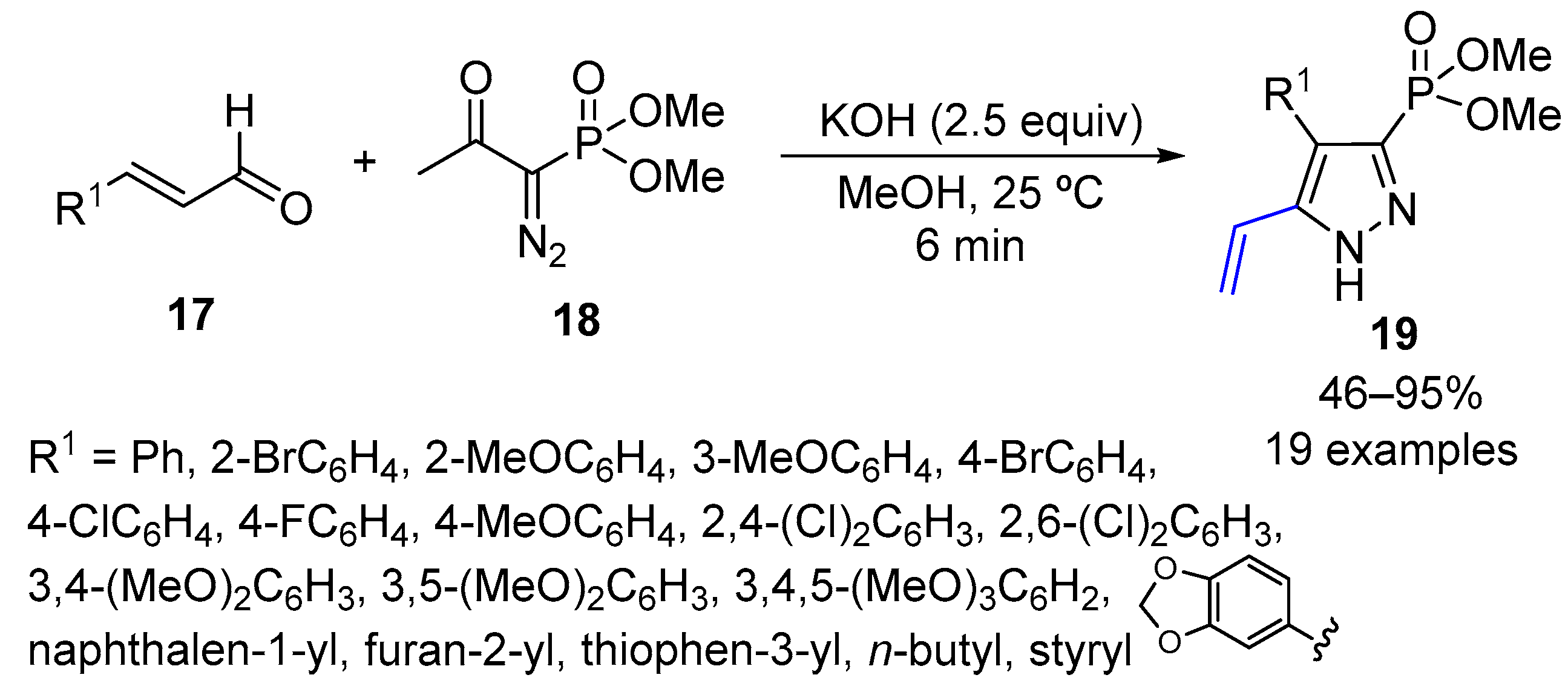




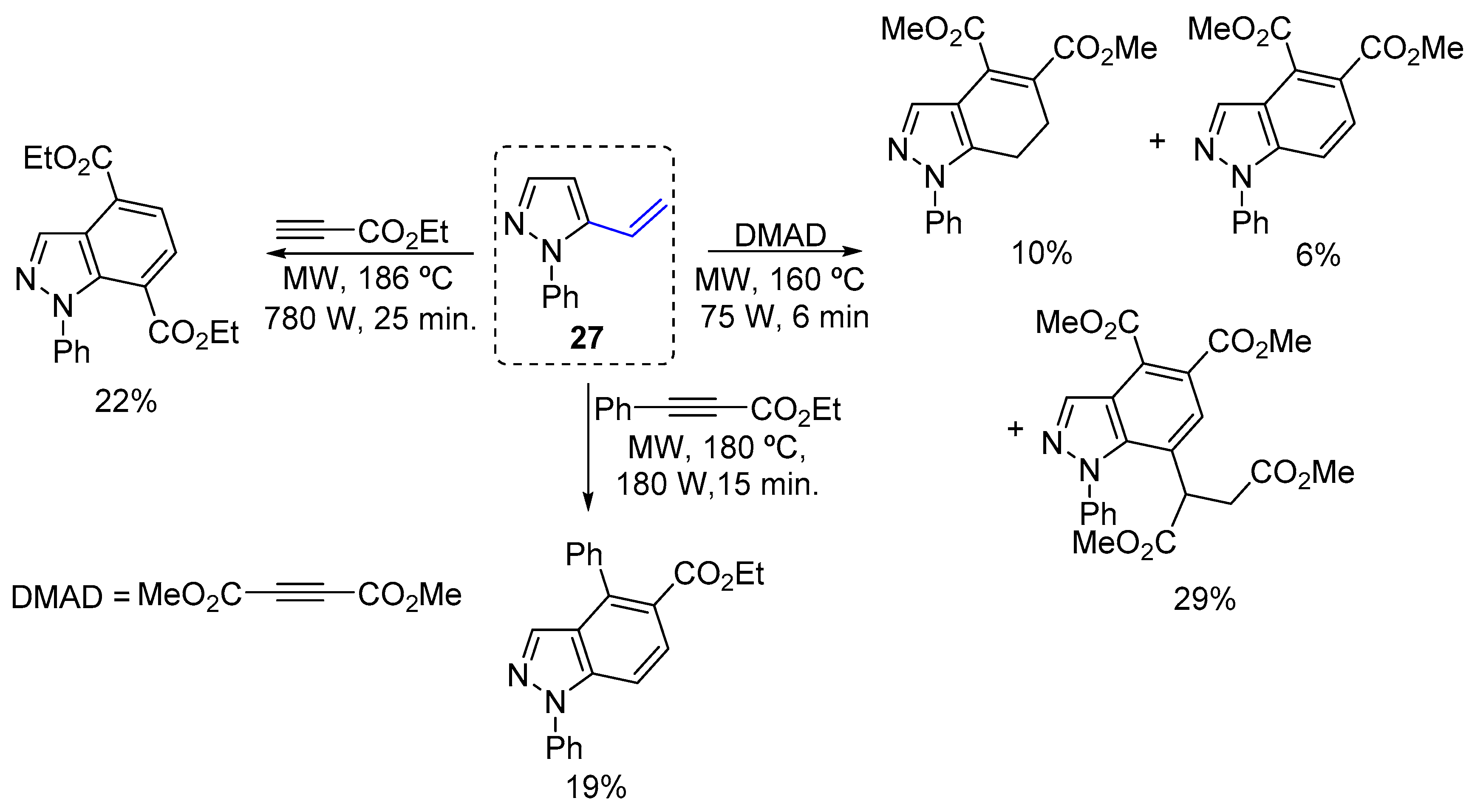
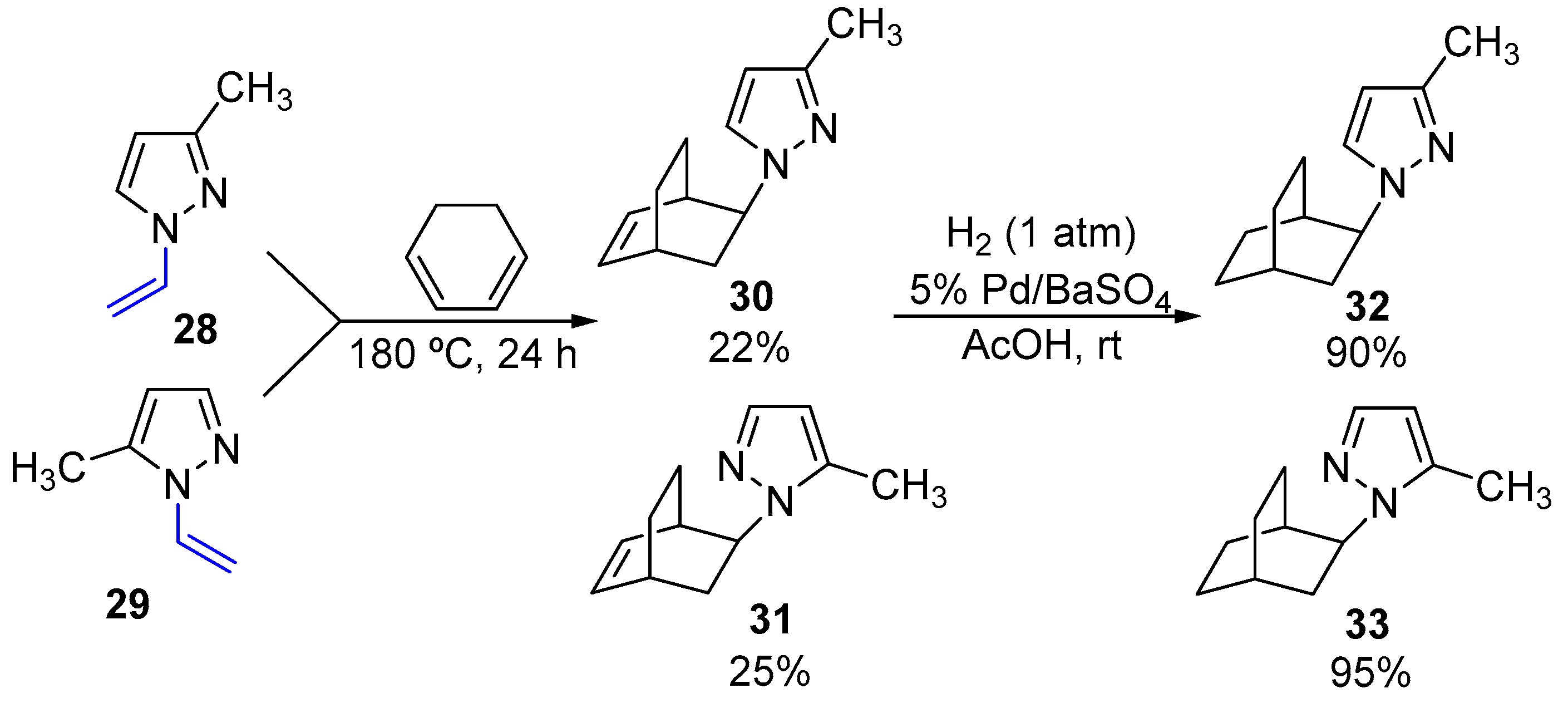
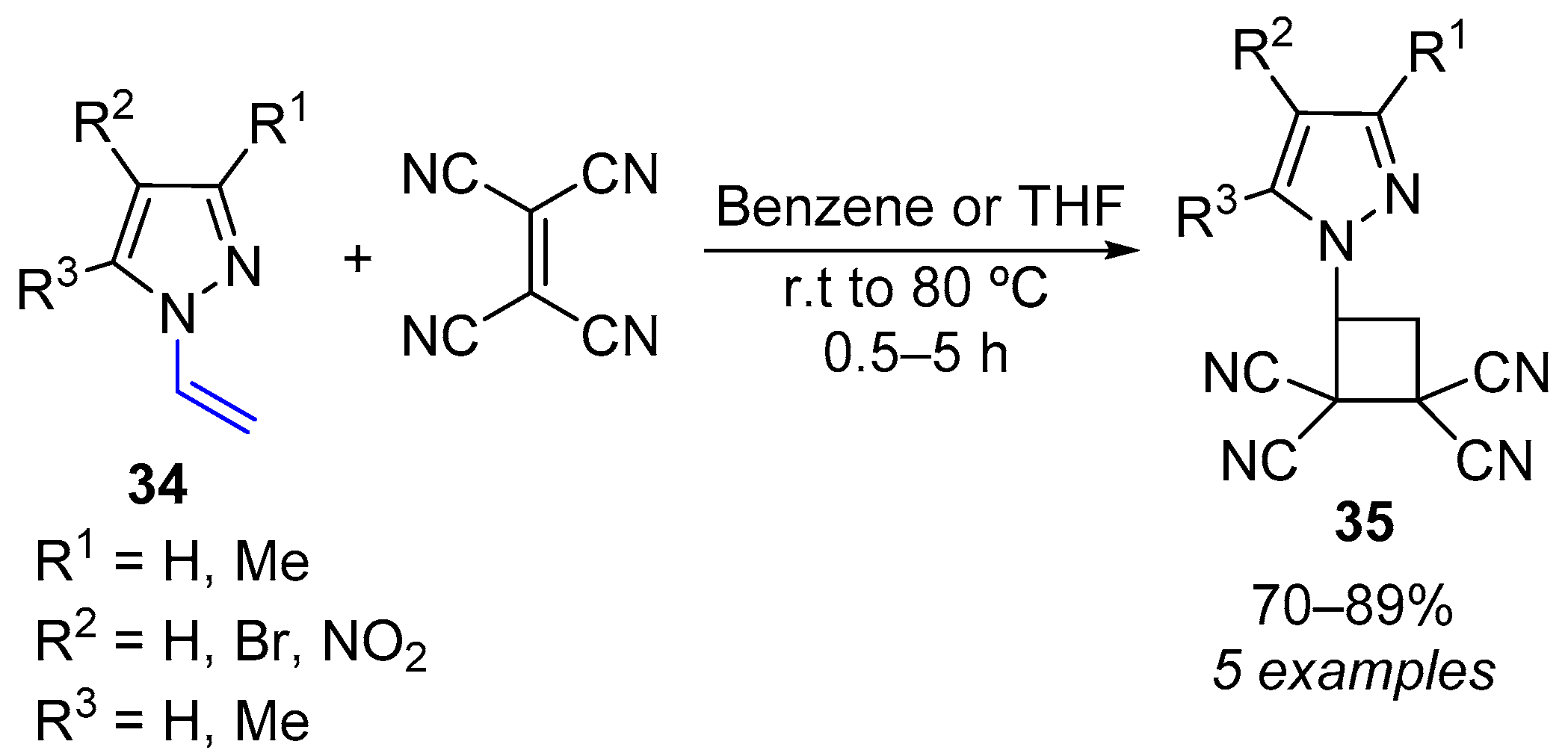


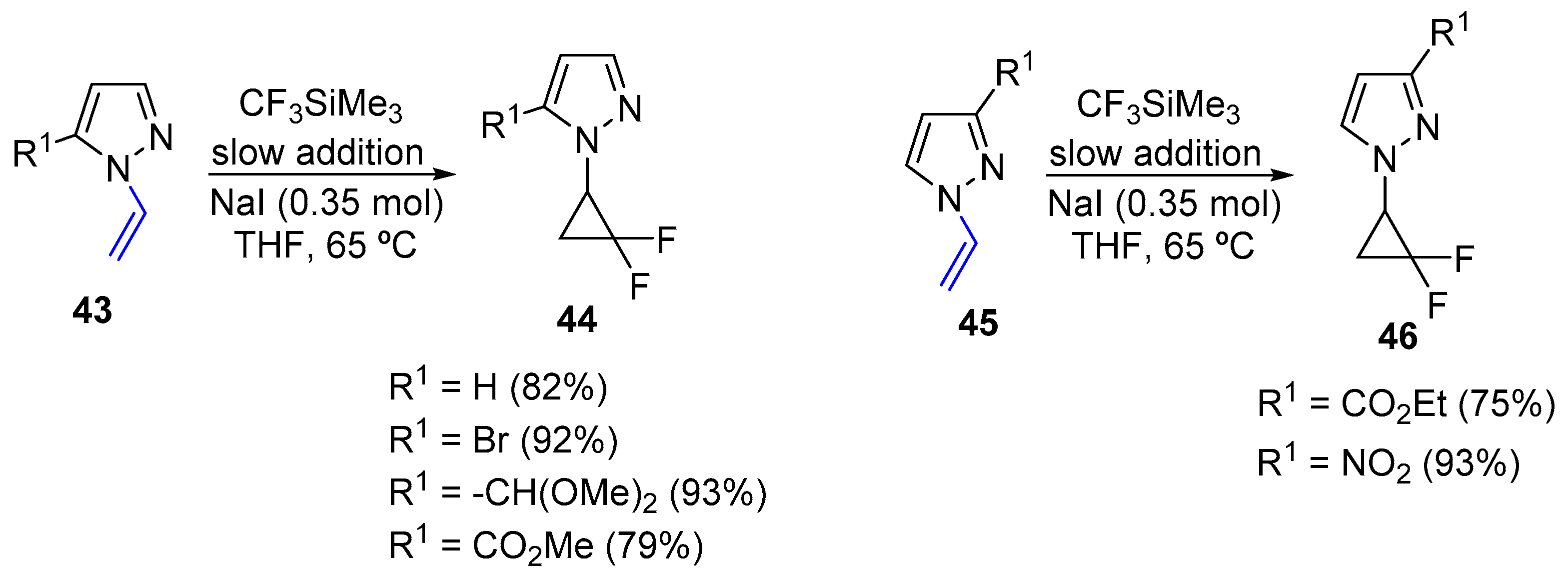
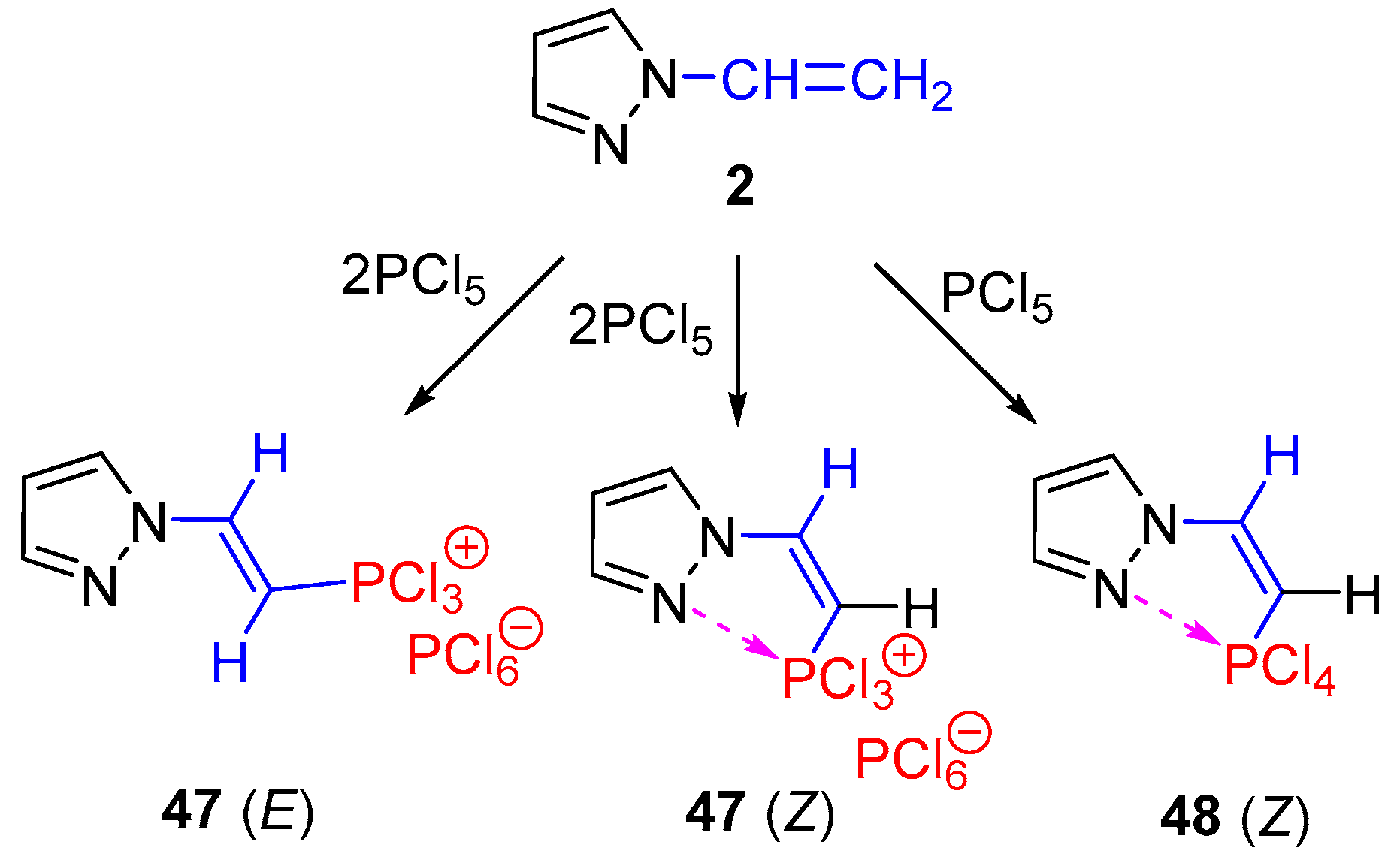

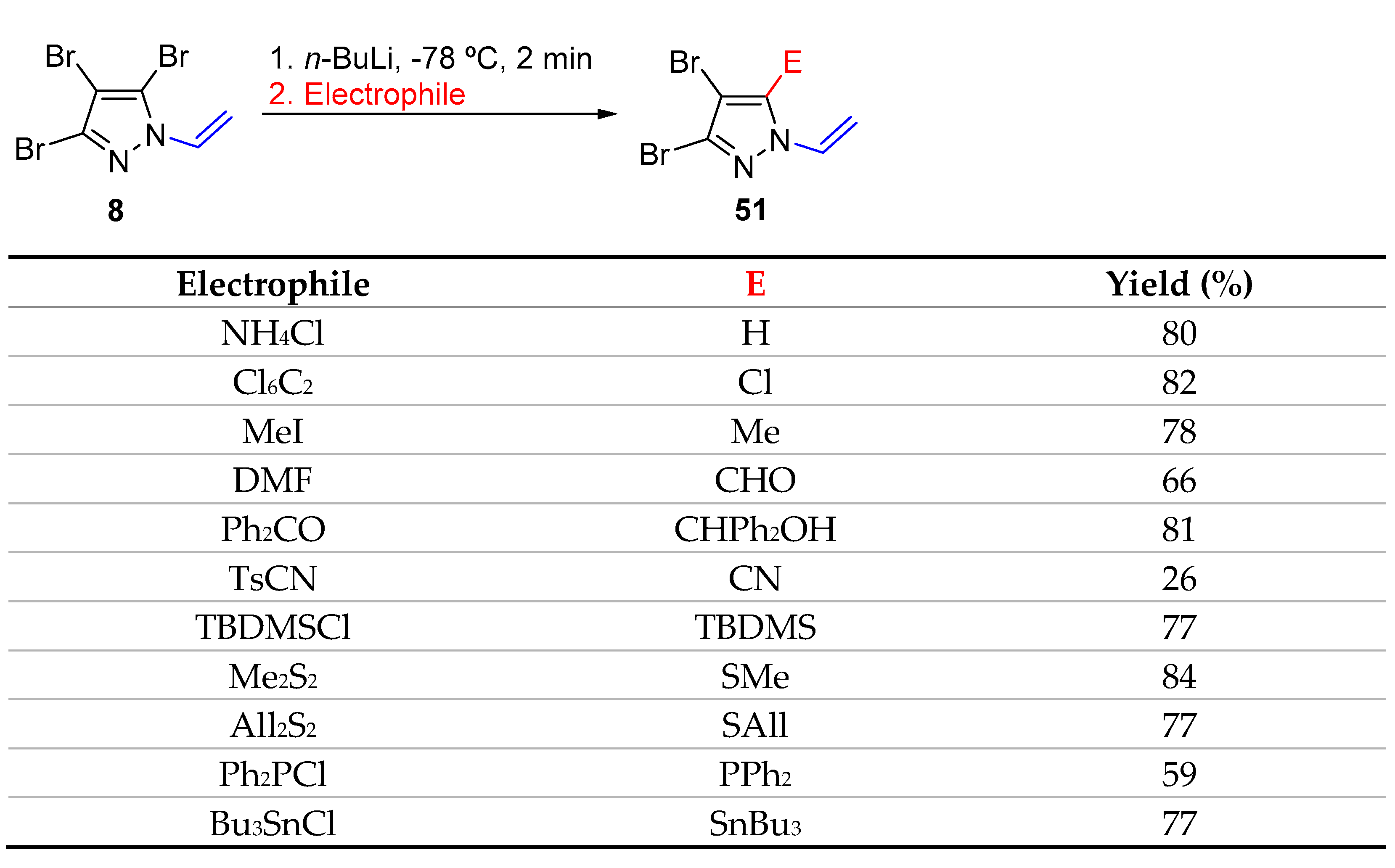

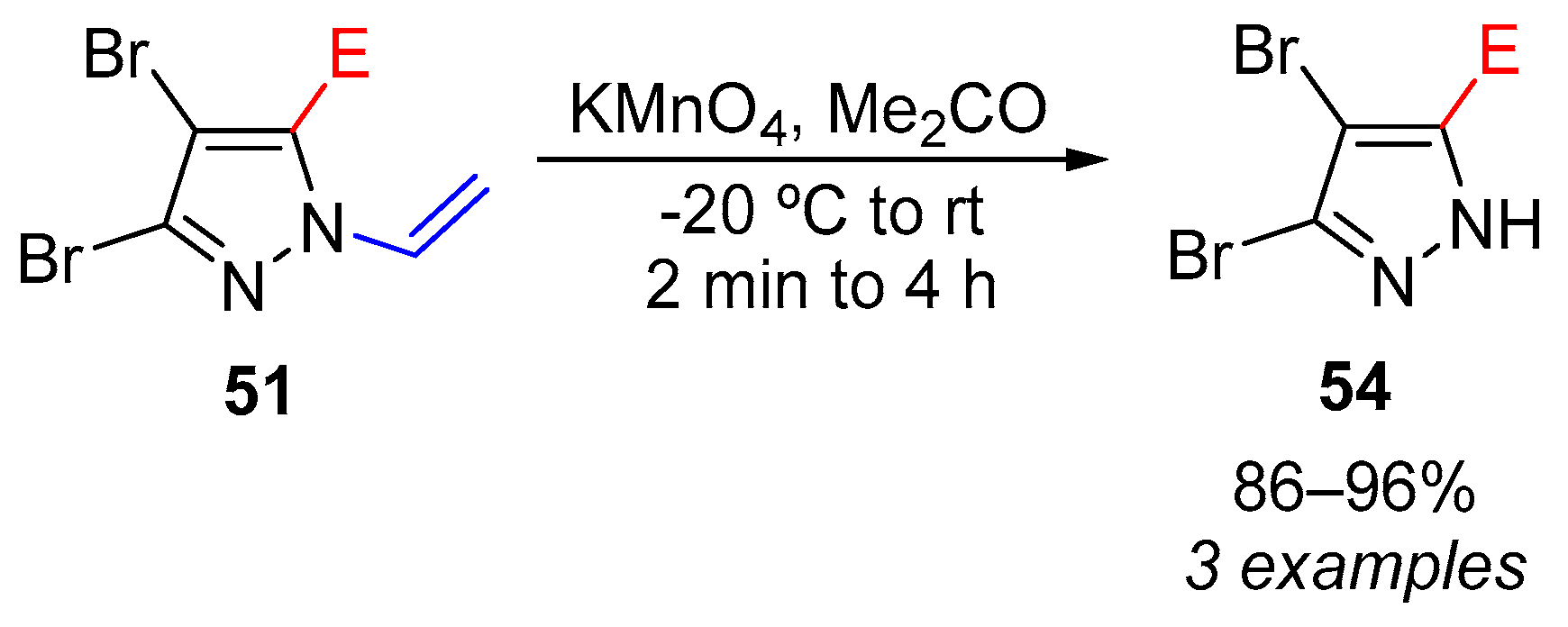

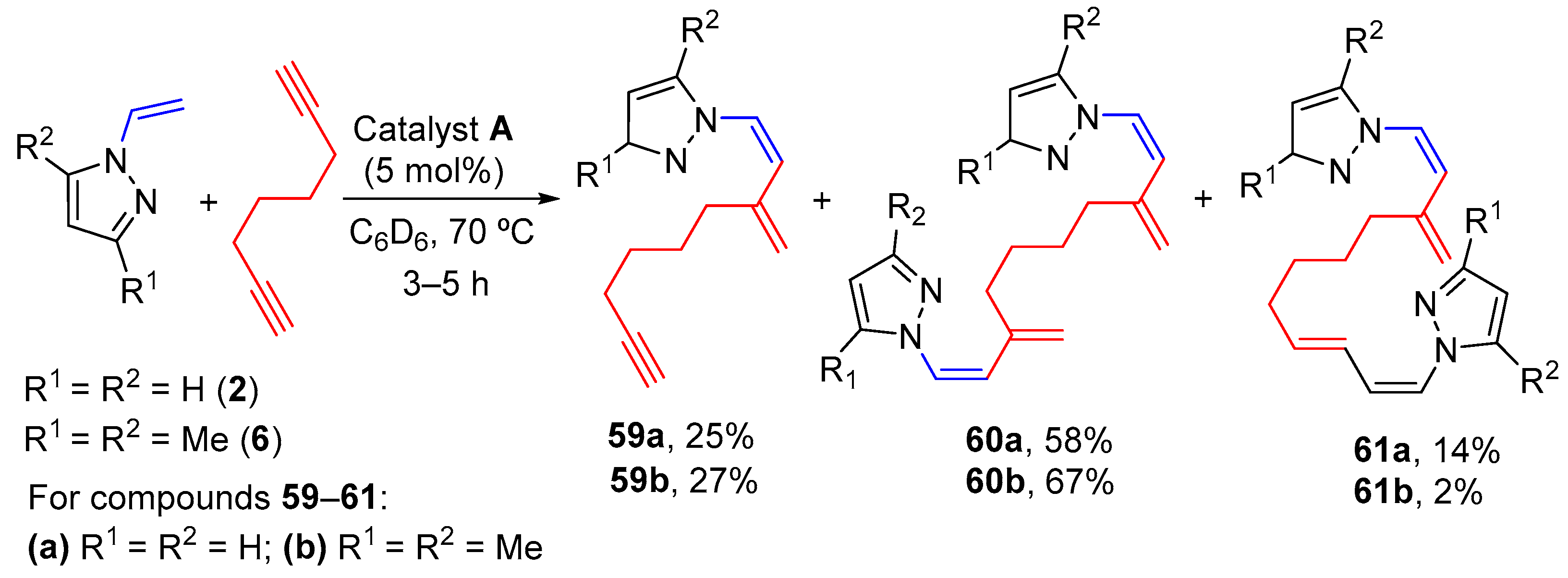
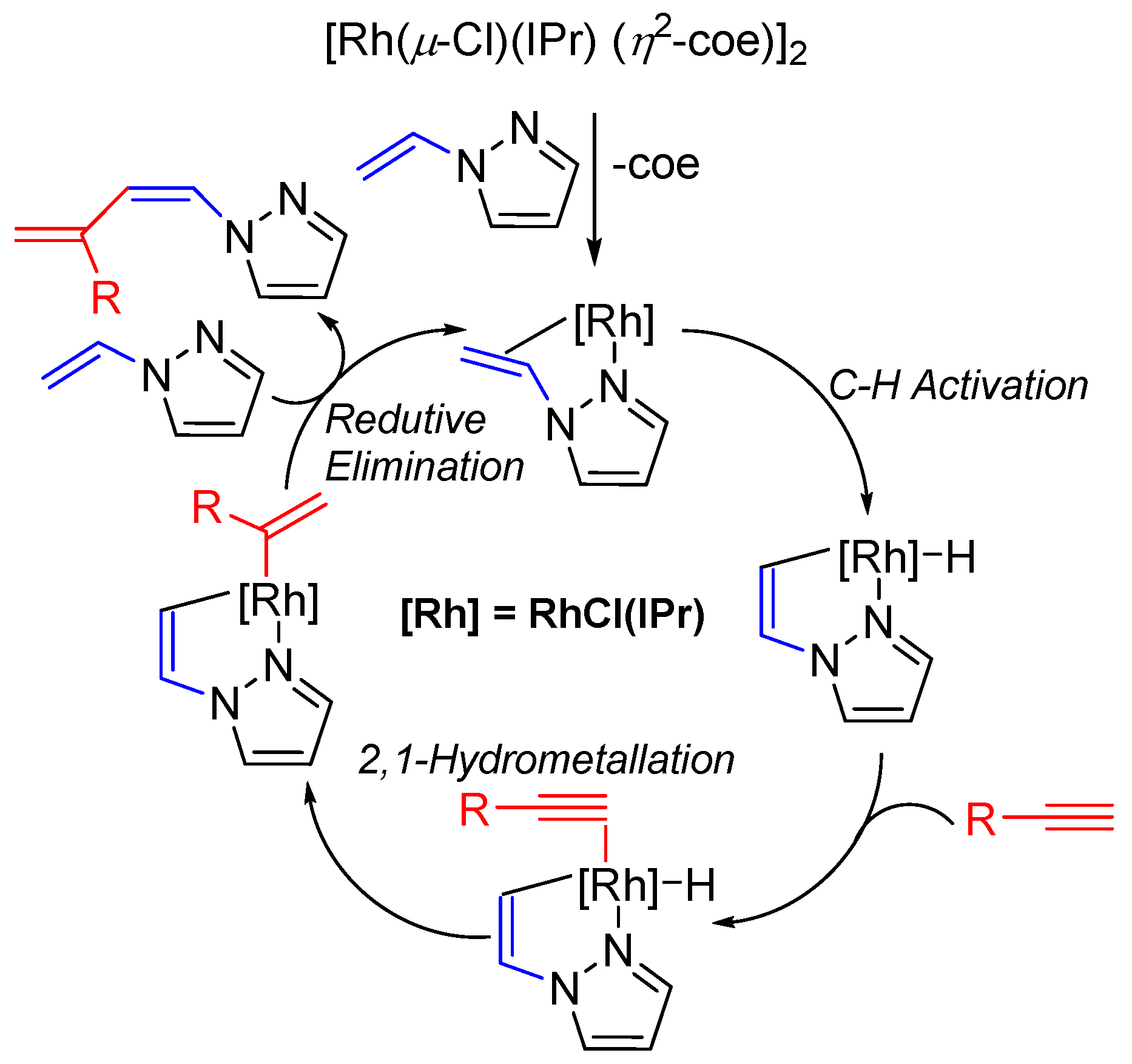
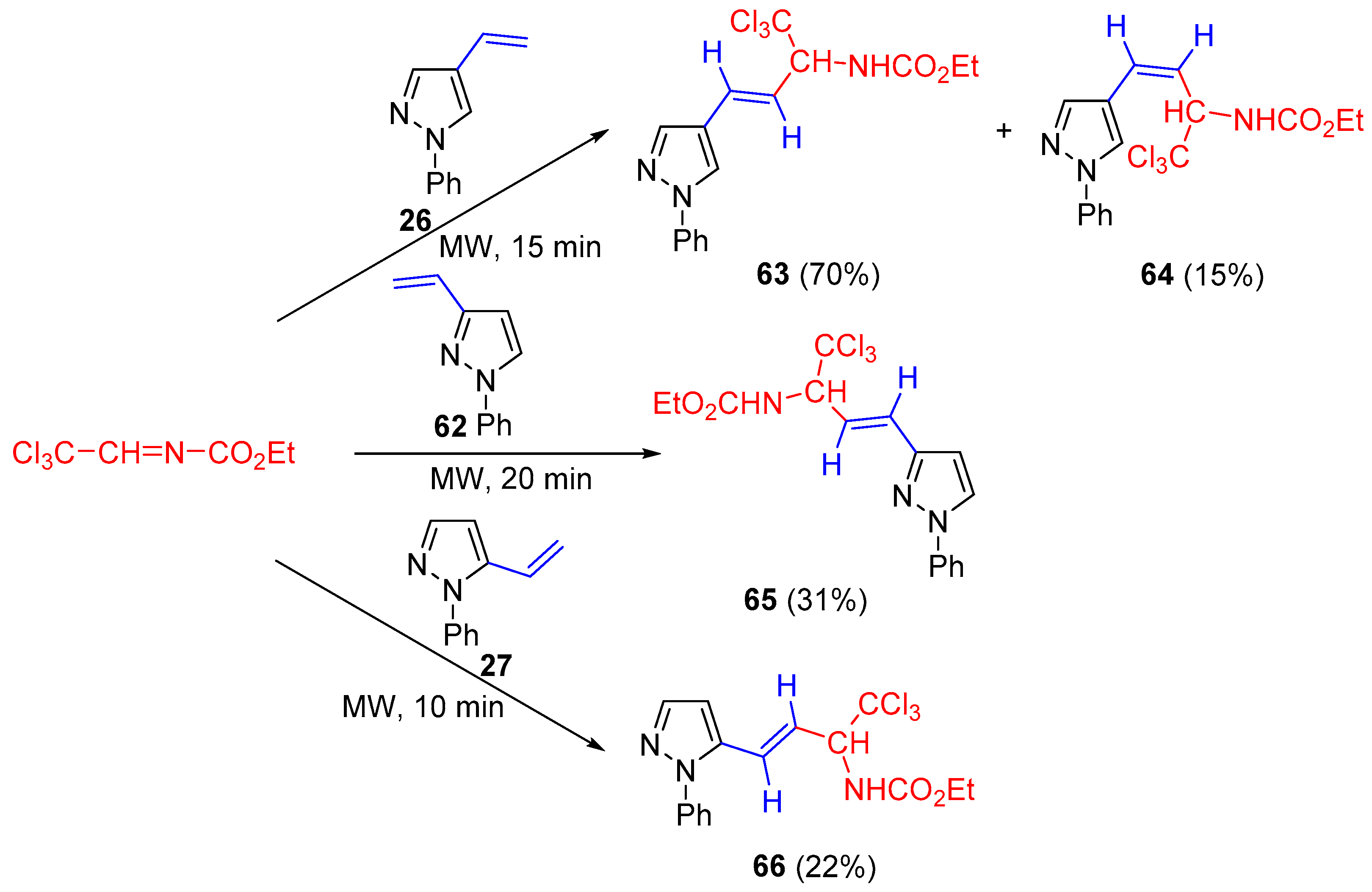

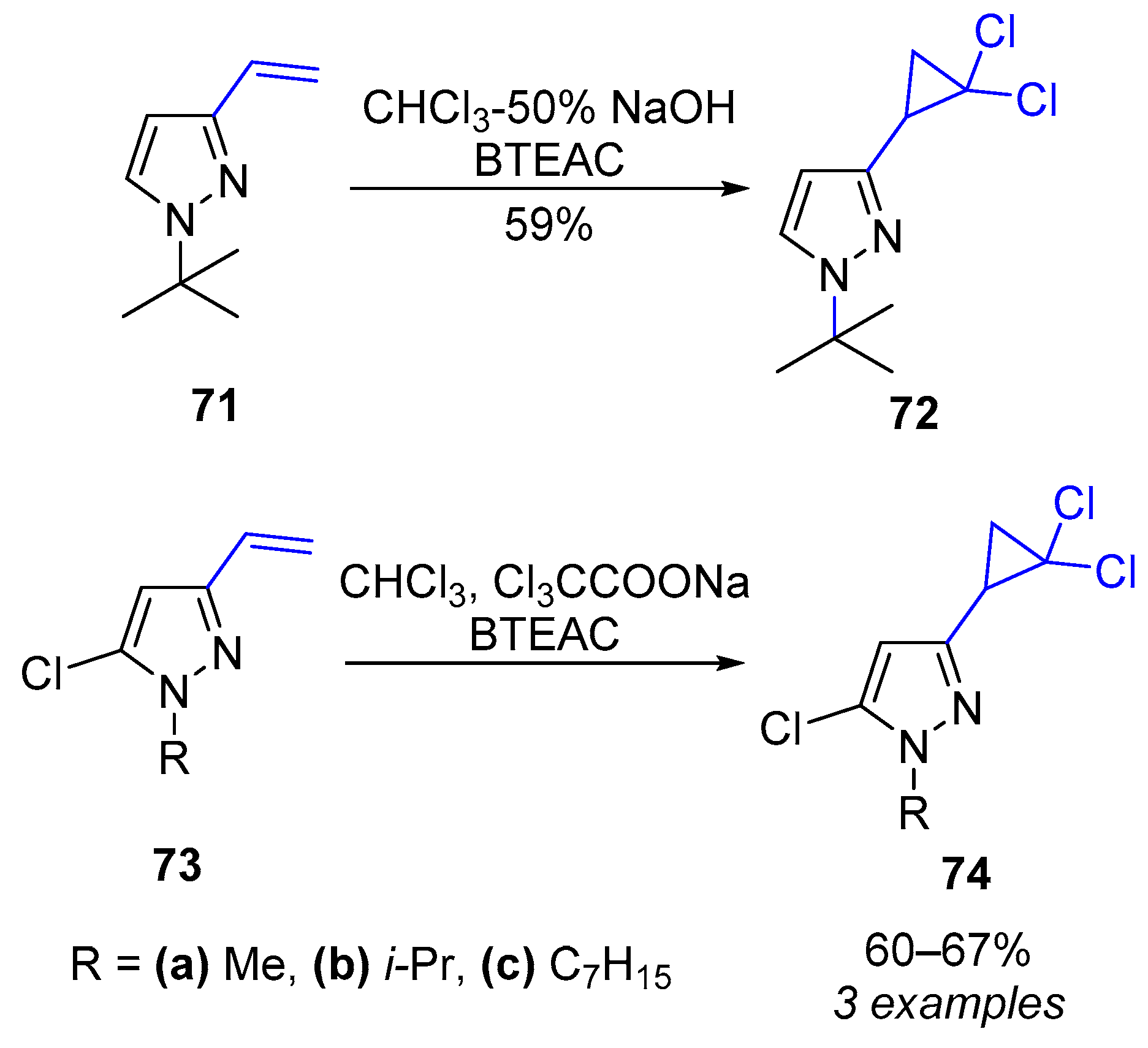
Publisher’s Note: MDPI stays neutral with regard to jurisdictional claims in published maps and institutional affiliations. |
© 2022 by the authors. Licensee MDPI, Basel, Switzerland. This article is an open access article distributed under the terms and conditions of the Creative Commons Attribution (CC BY) license (https://creativecommons.org/licenses/by/4.0/).
Share and Cite
Silva, V.L.M.; Silva, A.M.S. Revisiting the Chemistry of Vinylpyrazoles: Properties, Synthesis, and Reactivity. Molecules 2022, 27, 3493. https://doi.org/10.3390/molecules27113493
Silva VLM, Silva AMS. Revisiting the Chemistry of Vinylpyrazoles: Properties, Synthesis, and Reactivity. Molecules. 2022; 27(11):3493. https://doi.org/10.3390/molecules27113493
Chicago/Turabian StyleSilva, Vera L. M., and Artur M. S. Silva. 2022. "Revisiting the Chemistry of Vinylpyrazoles: Properties, Synthesis, and Reactivity" Molecules 27, no. 11: 3493. https://doi.org/10.3390/molecules27113493







